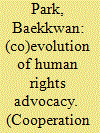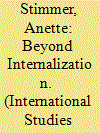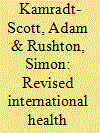| Srl | Item |
| 1 |
ID:
167398


|
|
|
|
|
| Summary/Abstract |
How does the discussion of human rights issues change over time? Without advocates adopting a human rights issue in the first place, international ‘shaming’ cannot occur. In this article, we examine how human rights discussions converge and diverge around new frames and new issues over time. Human rights norms do not evolve alone; their prevalence, framing, and focus are all dependent on how they relate to other norms in the advocacy community. Drawing on over 30,000 documents from dozens of human rights organizations from 1990 to 2011, we provide a temporal overview and visualization of the ebb and flow of human rights issues. Using our new dataset and state-of-the-art methods from computer science, our approach allows us to quantitatively examine (a) how new issues emerge in the advocacy network, (b) the relationship of these new issues to extant human rights advocacy and information, and (c) how the framing and specificity of these issues change over time. By focusing on the process by which a new issue gets incorporated into the work of advocates, we provide an empirical assessment of the first step in the causal process connecting shaming to improvement in human rights practices.
|
|
|
|
|
|
|
|
|
|
|
|
|
|
|
|
| 2 |
ID:
167428


|
|
|
|
|
| Summary/Abstract |
Norm scholars tend to treat norm contestation and acceptance as binary categories. This obscures variation in how much states agree over how to apply international law to specific situations. I distinguish between disagreements over norm frames (justifications) and claims (actions) and thus highlight four different outcomes of norm contestation. These differ in their effects on the clarity and strength of the contested norms, as well as on subsequent debate over them. Specifically, I argue that frame agreement limits the range of actions that actors can legitimately pursue and thus involves norm recognition. In contrast, if states only agree on the action that should be taken, but not on the norm that applies, we see norm neglect. Both outcomes structure subsequent debates, but norm neglect is the more volatile outcome: because of the lack of normative commitment, states can justify the agreed-upon action as exceptional compromise and later revert back to a norm impasse (frame and claim disagreement). However, the joint action may also trigger socialization processes that lead to agreement on both frames and claims—that is, produce norm clarification. Hence, this typology builds a bridge between understandings of contestation as a never-ending debate and as an avenue toward agreement; it helps improve our understanding of compliance mechanisms and of contestation.
|
|
|
|
|
|
|
|
|
|
|
|
|
|
|
|
| 3 |
ID:
109870


|
|
|
|
|
| Publication |
2012.
|
| Summary/Abstract |
This paper takes a constructivist approach to examining one of the new norms embodied in the recently revised International Health Regulations (IHR). The paper focuses on the provisions that seek to restrain states from applying disproportionate international travel and trade restrictions in response to a disease outbreak occurring in another country. This new norm, which aims to limit unjustified 'additional health measures', has significant implications for state sovereignty. Using the example of the 2009 H1N1 'swine flu' pandemic, the paper examines whether state behaviour and the discourse surrounding that outbreak supports a constructivist contention that a new norm has been created and that most states can be expected to comply with that norm most of the time. We conclude by discussing what the discourse over H1N1 suggests about the extent to which the new norm concerning additional health measures has been internalized by states.
|
|
|
|
|
|
|
|
|
|
|
|
|
|
|
|
| 4 |
ID:
145068


|
|
|
|
|
| Summary/Abstract |
This article examines the trajectory of sustainable development as an evolving international norm from 1992 to 2012. It observes that sustainable development has been broadly diffused and institutionalized. Yet it is generally recognized that it has not prompted widespread change in the behavior and policy priorities of states: an outcome the article characterizes as a “failure to launch.” It explains the stalling of the norm by drawing attention to the protracted norm definition process. It analyzes an original dataset of speeches given at UN conferences on sustainable development, revealing how actors interpret the norm at three different time points. The analysis focuses on the breadth of conceptual consensus that emerges from these actors' interpretations and the depth of behavioral expectations implied by the collective discourse. It suggests that the shifting content and unstable discursive consensus regarding sustainable development has impeded the norm's ability to become a meaningful focal point for coordination and a legitimate constraint on state behavior.
|
|
|
|
|
|
|
|
|
|
|
|
|
|
|
|